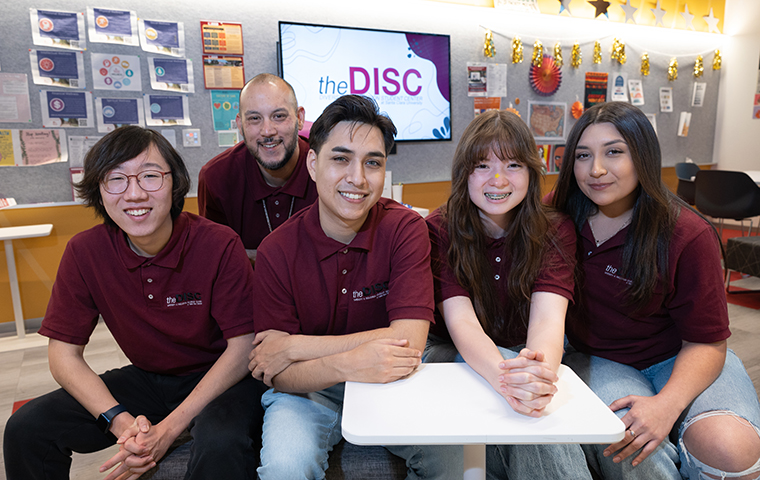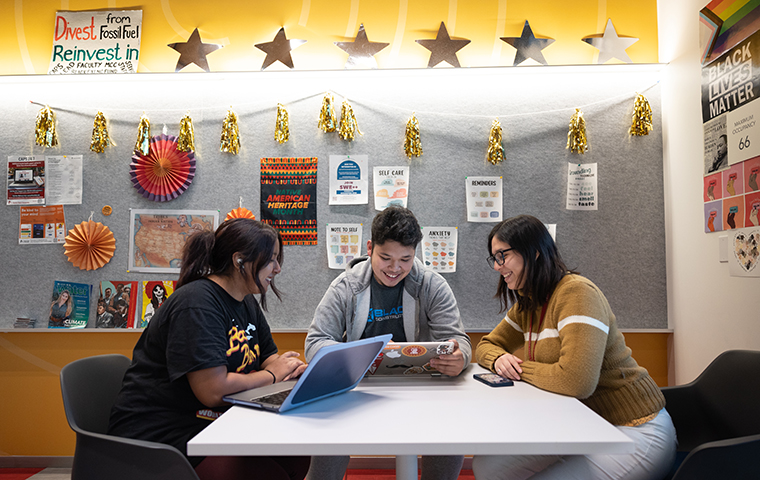
‘A Sense of Belonging’
Just a year after opening, the Diversity and Inclusion Student Center is a critical and beloved safe space for underrepresented STEM students, serving an average of more than 250 students per week.
Before the Diversity and Inclusion Student Center (DISC) opened in the Sobrato Campus for Discovery and Innovation last fall, Ricardo Padilla, Jr. noticed a trend: many of the students he worked with in the School of Engineering weren’t aware of all the resources available to them. And when they did, they were often reluctant to reach out.
“Generally our students have introverted personality tendencies, and they’re also juggling a heavy workload,” says Padilla, programs director for Diversity, Equity and Inclusion in STEM. “And when they needed help, they were so busy they did not want to invest their time in potentially going to places and it being unfruitful for them.”
“They preferred to suck it up, do their work, and try to grind through it. The only person they would go to was to me.”
When the DISC opened, Padilla made it his personal mission that, in addition to serving as a gathering point for underrepresented students in STEM, it would also connect them to important resources on campus, like the Cowell Center and the Office for Multicultural Learning.
One year later, the space has started to accomplish that and so much more. Between mid-winter quarter last year and finals week of spring quarter last year, DISC saw an average of 255 students each week, including graduate students from the law and business schools. Student workers say they point peers to resources, such as the University’s food insecurity program and the Wellness Center, an average of 14 students per week.
It’s a refuge. A saving grace. A place for students to fully be themselves.
With couches, games, desks, and whiteboards, DISC has become a haven for late-night cramming sessions or catching-up with friends. It’s often abuzz with activity: in its first year, DISC supported 13 University events, including the STEM Diversity BBQ and a keynote by environmental engineer Tracy Fanara. Campus partners and clubs reserved the space 90 times for meetings, receptions and workshops, including the LEAD Scholars program, Campus Ministry, and the Women in STEM club, among many others.

Ricardo Padilla, Jr. (back left) and his team of student workers.
Once a week, staff from the Career Center spend an hour at DISC to meet with students and answer questions. The idea is that when students have career questions, they will already have met or established connections with the people they’ll go to for help, says Padilla. These connections are central to DISC’s mission.
Padilla manages the space with the help of student workers, the majority of whom are first-generation college students whom he mentors. As a first-generation student himself with a background in counseling and psychology, Padilla has taken many of these students under his wing. He says his main objective is for DISC to be inclusive to all, no matter their background.
“It’s so important for our students’ mindsets and sense of belonging—especially coming to Santa Clara, a historically predominantly white institution—to have this space,” says Padilla. “Many of our students battle imposter syndrome. It’s crucial for them to have a safe space where they can study, vent or just talk out loud. It’s also important that they have people there to help, who are living examples of the same things they’re going through and have overcome those hurdles.”
Room For Everyone
When Brynn Kramer ’24 first came to Santa Clara, she knew that she wanted to immerse herself in clubs and programs that promote diversity, equity, and inclusion. In high school, Kramer was a member of several DEI-focused groups, including Anytown Leadership Camp, an organization that educates and encourages young people to promote social change.
It was important for her to continue these efforts in college, but she didn’t quite know what that would look like at Santa Clara. A job posting for a student assistant role at the Diversity and Inclusion Student Center would help her fulfill that purpose.
Kramer is one of four students who help manage DISC, helping facilitate events, answer questions, and point students to resources on campus. DISC aims to provide a safe and inclusive space to students in the School of Engineering and College of Arts and Sciences who are looking for a sense of community. But for students like Kramer, DISC means so much more.
“I’m a bisexual, half Filipina girl. Diversity and social justice have always been super important to me,” says Kramer, a political science and ethnic studies major. “I want to work in civil rights law one day. These are the things I really care about, and the Diversity and Inclusion Center is such a great source for that. It’s fulfilled that passion in my life.”
One of the most meaningful connections Kramer has made is helping a student locate the Rainbow Resource Center, a safe space for LGBTQ+ students on campus. Kramer works at DISC on weekday afternoons and sometimes hosts her own events there. She put together a Filipino folklore night on Oct. 30 in honor of Filipino Heritage Month and Halloween.
Through a wellness grant from student government, Kramer put together a “rage room” on another part of campus, where survivors of sexual assault and their allies could safely express their emotions as part of their healing. They capped the day off with a meditation cool down in DISC. These events, and so many others, have helped Kramer fulfill her purpose of advancing DEI on campus.
“It’s super important to know that there is a space that is designed for underserved communities,” says Kramer. “For a long time, there have not been any resources for them, and the spaces that are supposed to be for everyone often push these groups out. Knowing that at the very least we’re working to fix that and specifically making something that supports underserved communities is really amazing.”
Growing the Impact
Cinthya Jauregui ’22, M.S. ’24 knows all too well how isolating the world of STEM can be for people like her. As an undergraduate student, Jauregui created her own major in human computer interaction in the School of Engineering. Jauregui is now pursuing a master’s degree in engineering at Santa Clara, and hopes to become a product manager. She’s often the only Latina in the room, she says.
DISC became a gathering place for Jauregui’s undergraduate friend group immediately after it opened last year. They would hang out, eat meals, and play games. When finals came around, Jauregui and her friends would study in DISC until 3 a.m. and doze off on the couches. The space is inherently welcoming, she says.
“When you’re there, you know that whoever is there is supportive of being inclusive or mindful of being inclusive,” says Jauregui. “That, in itself, allows you to be more open and comfortable.”
Jauregui said it’s important that the space also welcome students outside of STEM majors—a mindset that Padilla shares. His ultimate goal is for the University to create spaces like the DISC throughout campus.
“My ultimate goal for DISC is for it to be emulated in every academic building,” he says. “To really make the campus and students feel included in everything, this model needs to be everywhere. And it needs to be inclusive. I’m very big on empathy and helping people be aware of others and where they are coming from.”
